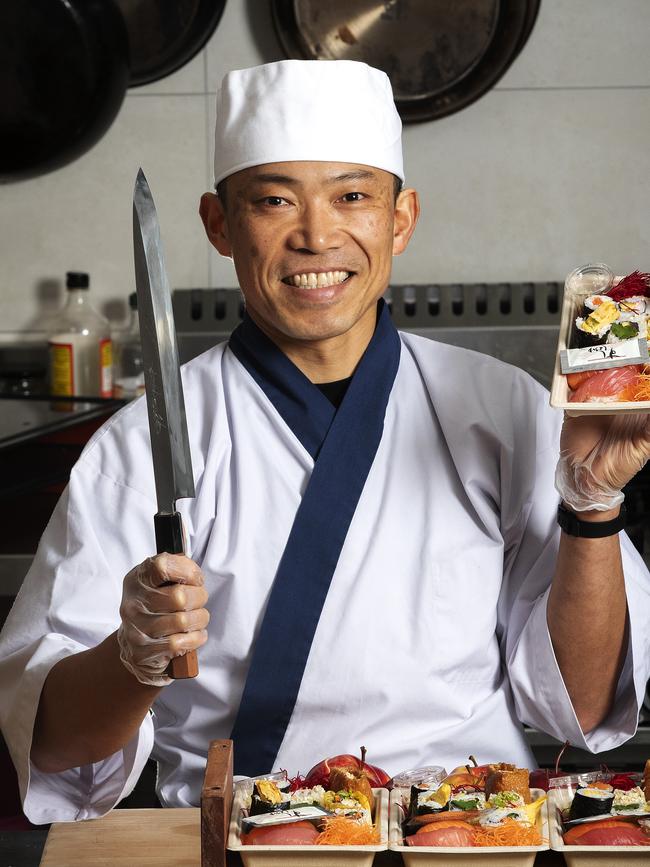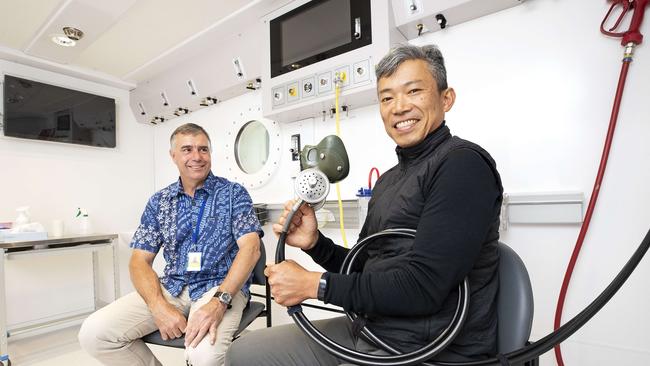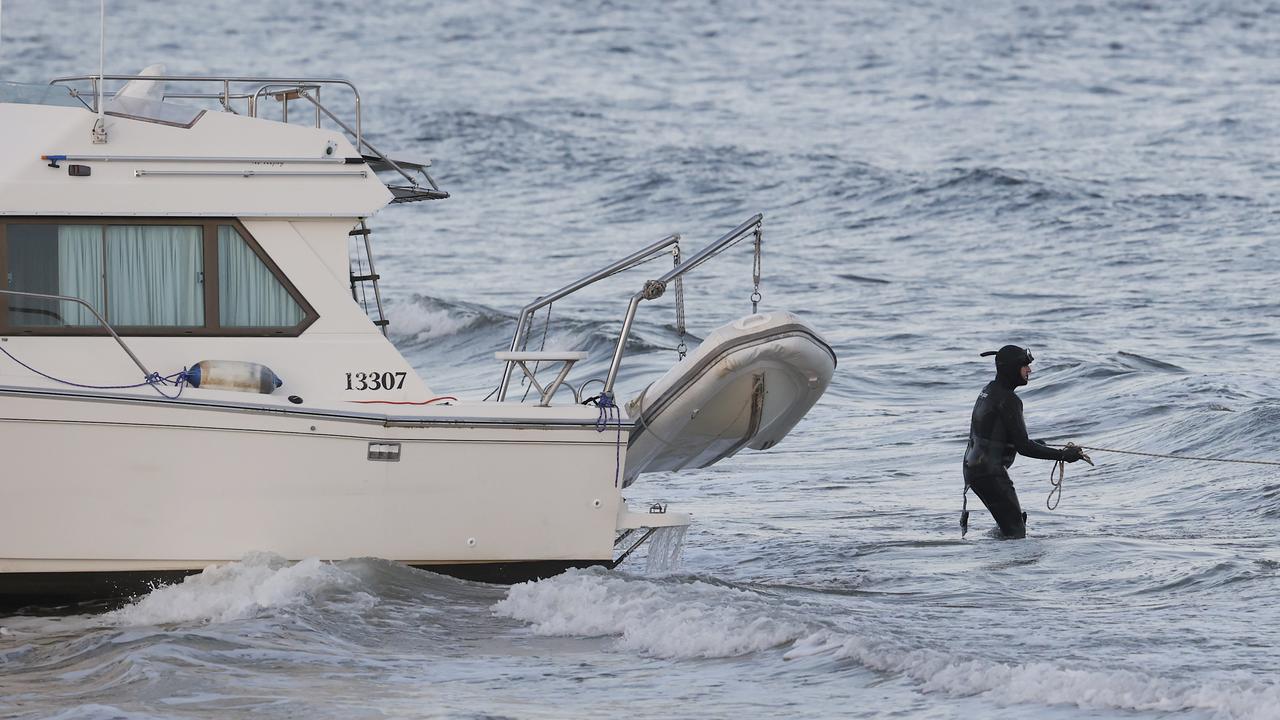‘Just too dangerous’: Sushi chef wants Tasmanians to think twice about hookah diving
Tasmanians’ love of the water and laid-back rules around hookah diving are a deadly combination, doctors are warning after a beloved sushi chef had a close call. WATCH THE VIDEO >>

Tasmania
Don't miss out on the headlines from Tasmania. Followed categories will be added to My News.
- Push for ‘peace deal’ between recreational and commercial anglers in Tasmania
- Can’t travel? Buy a boat like many Tasmanians
CHEF Masaaki Koyama is urging other divers to undergo training and check their equipment after a Bruny Island scalloping trip landed him in hospital.
For the past week the renowned sushi chef has been undergoing treatment for decompression sickness, known as “the bends”, after hookah diving for scallops with friends.

He hopes his experience will serve as a warning to others, particularly as more Tasmanians head to the coast to take advantage of the scallop and rock lobster seasons.
Although hookah diving is unregulated in Tasmania, with no requirement for equipment to be professionally serviced, Mr Koyama said training should be mandatory.
“I feel extremely lucky. I knew about the risk but it’s so complicated to make sure of everything and I think everybody needs to be trained or they will end up like me,” Mr Koyama said.
He spent about 40 minutes on the seabed in about 12 to 14 metres of water.
“I was coming up from the bottom slowly, but then I saw another scallop and, like all fishermen, I thought ‘I need a bit more’ so I went back down again,” he said.
Another mistake was driving home to Glen Huon via the fastest route, over Vinces Saddle, which has an elevation of 430m.
“I think a lot of people make this mistake,” he said.
Mr Koyama said he initially ignored the aches in his joints and ringing in his ears, until a few days later he realised it was getting worse and was taken by ambulance to the Royal Hobart Hospital’s hyperbaric medicine unit.
He required six hours in a high-pressure chamber after his first night in hospital and then returned each day for subsequent two-hour treatments, driving home each time via the longer, flatter coastal route.
“I feel very grateful and want to share the message that diving illness is really serious and can lead to long term damage all your life. For young people especially, hookah diving is just too dangerous,” Mr Koyama said.

Tasmanians’ love of the water and laid-back rules around hookah diving are a deadly combination, Royal Hobart Hospital doctors are warning.
Co-director of the Royal’s new hyperbaric medicine unit David Smart said more Tasmanians than ever were taking up recreational diving, which had the potential to drive up the state’s already high number of related injuries and deaths.
“We’re coming into the cray season now, which is going to see a spike in activity among recreational divers and we’ve also got an overlap of the scallop season with the cray season, which is the first time that’s ever occurred. So people are going to be diving for lots of seafood,” Professor Smart said.
Tasmania has nearly four times the national rate of diving-related deaths per capita, although that is likely to be influenced by Tasmania’s high participation rates.
Already, since the hyperbaric unit opened in March, 12 scuba and hookah divers have been treated for diving illnesses.
Prof Smart said the use of “dodgy” hookah equipment was a problem that continued to result in deaths and horrific injuries, including to the lungs, muscles and joints.
“I’ve been in diving medicine for 35 years and the problems keep reoccurring,” Prof Smart said.
“There are some issues that keep reoccurring when people die and also with near-misses. Like a good dentist we want to prevent them from occurring in the first place.”
Prof Smart said there was a “desperate need” for compulsory hookah education.
He also urged divers to rig up a safety buoy to help with navigation and hauling up a catch of seafood.
“With scallops the size they are this year, 50 scallops can weigh at least 20kg and we’ve had numerous cases where divers have dropped both their weight belt and their scallops to save themselves from drowning and they have come to the surface too quickly. It’s a hazardous process,” he said.
Prof Smart said it was vital to ensure equipment was up to scratch and to avoid splitting the air hose to allow two people to dive at once, which he said was extremely dangerous, as one diver would “steal” air from the other.
“Hookah set-ups require an engine for air supply, which is basically a lawn mower engine and as everyone knows, lawnmowers often stall and fail,” he said.
“If it fails, and the diver has to move through the water column quickly, they can get decompression illness or they can rupture their lungs and end up with gas embolism and a massive stroke and become unconscious.”
Another big risk was the engine’s exhaust poisoning the diver’s air supply, particularly if the weather changes.
“We’ve had divers die in the past from carbon monoxide poisoning and we’ve had some near misses where divers have come in very very sick,” Prof Smart said.

Prof Smart congratulated Mr Koyama for speaking up about his experience of decompression sickness to raise awareness about the risks around hookah use and driving home along elevated roads after a dive trip.
“One of the things with Masaaki’s condition is, if it’s not treated, it can lead to damage to bones and joints,” Prof Smart said.
“If a patient comes in with paraplegia or quadriplegia (as a result of diving illness), if you don’t get the earliest possible treatment you’re in serious trouble and if you do get treatment, it is only partially effective, so I would encourage people to report symptoms as soon as they occur.”
“Another thing is to beware of going to altitude after diving because that can result in depressurisation and the bubbles in your body get bigger. There are a lot of hills in Tasmania and it is better to plan your travel for the day after your dive,” he said.


